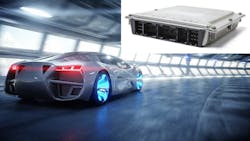What’s the Difference Between CAN and SPE in the Automotive Industry?
What you’ll learn:
- How single-pair Ethernet is taking over for CAN bus.
- How SPE improves on CAN.
It's been 36 years since the CAN (controller area network) bus was released by the SAE (Society of Automotive Engineers). Lying at the heart of vehicle communications for decades, it supports a wide variety of automotive innovations.
The CAN bus is described as a vehicle bus standard that allows microcontrollers and devices to communicate with each other's applications without a host computer. It's a message-based protocol, designed originally for multiplex electrical wiring within automobiles to save on copper, but it also can be used in many other applications.
Automotive technology has come a long way since the first CAN buses were deployed, and the platform has since been tasked with more and more functions beyond what was envisioned in the 1980s.
CAN remains a favorite of auto manufacturers even into its fourth decade. That said, the automotive industry has been undergoing a paradigm shift in response to cutting-edge technologies and fast-evolving consumer demands. CAN's long-running reign is set to face new challenges.
To that end, the automotive industry is looking toward single-pair Ethernet (SPE) to function as the automotive network's backbone, an alternative that brings higher performance, increased security, and increased efficiency over CAN buses.
According to a 2020 market report, the global connected-car market is expected to reach $225.16 billion by 2027, up from $63.03 billion in 2019. This shift toward increased connectivity will play a decisive and accelerating role in the move to SPE networks, even as CAN buses continue to provide an important communication medium (primarily for legacy components).
CAN Bus Advantages and Limitations
CAN's technical features have made it effective in the vehicular environment, starting with its high tolerance for noise that’s supported by CAN's physical layer and protocol.
Moreover, CAN supports native multicast and broadcast, provides built-in frame priorities, offers non-destructive collision resolution, is 100% distributed in operation, and easily supports long single buses measuring in the tens of feet. With only a pair of wires and a cheap physical-layer interface, CAN still retains an attractive option in traditional automotive networking.
The CAN bus is limited to a maximum data-transmission rate of 8 to 10 Mb/s, making it challenging to keep up with the demands of current and next-gen connected vehicles. This means that as more devices become connected to the same bus, its performance is diminished.
Manufacturers have mitigated that issue by incorporating more CAN buses into vehicles, with some packing 10 or more. The ad hoc connections between these buses have been sufficient to facilitate network communications, but security is typically an afterthought, despite connected vehicles' increasing vulnerability to cyberattacks.
Upgraded CAN versions, including CAN FD and CAN XL, have improved on the basic design by supporting more throughput (from 1 Mb/s in traditional CAN to up to 10 Mb/s in CAN-FD/XL), faster line rates, and larger frame sizes. CAN FD is currently in production, while CAN XL remains in the design phase.
That said, CAN offers some features that manufacturers still find attractive, including its ability to be implemented into a single microcontroller, significantly reducing the amount of software needed to establish communication. It also can detect and recover from an error condition within 23 µs at 1 Mbit/s, while TCP/IP at 100 Mbits/s is limited to a response time of about 1 ms (a factor of roughly 44).
CAN also provides collision-free and predictable arbitration to manage network access between competing nodes. Furthermore, the bus can be implemented in industries outside the automotive field, including as a fieldbus in general automation environments, primarily due to the low cost of some CAN controllers and processors.
While these improvements will certainly enhance CAN's robustness and reliability as cars become more connected and autonomous, SPE offers another pathway to building a vehicle communications network that meets modern needs.
Single-Pair Ethernet and Its Advantages
Meeting the demands of next-generation connected and autonomous vehicles will likely require code that’s hundreds of millions of lines long, in contrast to the 50-100 million lines for current models. Thus, the industry is transitioning to SPE. It uses a pair of copper wires that can transmit data at speeds of up to 1 Gb/s over short distances while simultaneously delivering Power over Dataline (PoDL).
SPE’s plug-and-play capabilities are suited to the high-performance, service-oriented environments that will define next-gen vehicles. Devices can be connected and disconnected in real-time, with zero downtime, providing a significant advantage over CAN buses.
SPE also offers distinct advantages that necessitate integrating into a mixed-criticality automotive architecture. By supporting quality of service, security, time-critical extensions (time-sensitive networking, or TSN), and increased performance, SPE enables the high-performance communication required in zonal architecture.
Furthermore, it facilitates identifying and troubleshooting problems within in-vehicle systems. On top of that, SPE provides smaller wiring harnesses, resulting in reduced investments of time and resources than the installation of often-ungainly CAN systems.
SPE operates at full duplex and has a maximum reach of about 50 ft. (100BASE-T1, 1000BASE-T1 link segment type A) or up to 130 ft. (1000BASE-T1 link segment type B) with up to four inline connectors. Both physical layers require a balanced twisted pair with an impedance of 100 Ω. The cable must be able to transmit 600 MHz for 1000BASE-T1 and 66 MHz for 100BASE-T1. In addition, 2.5 Gb/s, 5 Gb/s, and 10 Gb/s over a 1-m single pair is standardized in 802.3ch-2020.
Transitioning to service-based communication and modular design are supported by Ethernet-based architectures rather than CAN buses, allowing for greater flexibility. This will be ideal as those hundreds of millions more lines of code are added to future car models, along with new infotainment capabilities, safety-critical features, over-the-air (OTA) updates, and autonomous and semi-autonomous features.
Moreover, SPE enables consistent data transmission up to the field level. This means that only one pair is required to transmit the signals instead of the previous two or four pairs, which benefits the automotive industry and its requirement profile. Additional advantages include the use of thinner cables, lowered costs for assemblies, less space and weight requirements, smaller bending radii, and fewer materials needed for manufacturing.
Conclusion
According to a report from Ixia, there are more than 400 million automotive Ethernet ports than for all other interfaces combined. Though SPE is still in its infancy, it's expected to command a market share of over $4.3 billion by 2024 due to increased demand for next-gen automotive features such as infotainment systems, advanced driver-assistance systems (ADAS), sensors, cameras and more.
As technological innovation continues at its current pace and consumer demands grow in tandem, a wide range of new applications and connected features will be integrated into vehicles. These include everything from more sophisticated ADAS to in-car gaming consoles. Integrating those new capabilities will require more bandwidth, smaller hardware, and increased data throughput, which is why more automakers are currently looking at SPE to handle those loads and more.
About the Author
Cabe Atwell
Technology Editor, Electronic Design
Cabe is a Technology Editor for Electronic Design.
Engineer, Machinist, Maker, Writer. A graduate Electrical Engineer actively plying his expertise in the industry and at his company, Gunhead. When not designing/building, he creates a steady torrent of projects and content in the media world. Many of his projects and articles are online at element14 & SolidSmack, industry-focused work at EETimes & EDN, and offbeat articles at Make Magazine. Currently, you can find him hosting webinars and contributing to Electronic Design and Machine Design.
Cabe is an electrical engineer, design consultant and author with 25 years’ experience. His most recent book is “Essential 555 IC: Design, Configure, and Create Clever Circuits”
Cabe writes the Engineering on Friday blog on Electronic Design.


